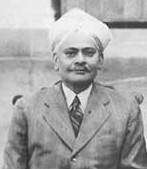N. Madhava Rao
Pradhana Shiromani Sir Nyapathi Madhava Rau, CIE (8 June 1887 – 28 August 1972) was an Indian civil servant and administrator who served as the Diwan of Mysore from 1941 to 1945.[1] He was a member of the Drafting Committee of the Indian Constitution.
Pradhana Shiromani, Sir Nyapathi Madhava Rau | |
|---|---|
 | |
| 23rd Diwan of the Mysore Kingdom | |
| In office June 1941 – August 1946 | |
| Preceded by | Sir Mirza Ismail |
| Succeeded by | Sir Arcot Ramasamy Mudaliar |
| Personal details | |
| Born | 8 June 1887 Masulipatnam, British India |
| Died | 28 August 1972 (aged 85) Bangalore, India |
| Alma mater | Pachaiyappa's College, Chennai |
| Profession | civil servant |
Early life and education
Madhava Rao was born in Masulipatnam to Nyapathi Venkatakrishna Rao on 8 June 1887. His ancestors were originally Deshastha Brahmins from Maharashtra who had settled in the Telugu country and adopted Telugu as their mother tongue.
Madhava Rau had his early education at Nobel College, Masulipatnam and graduated in arts from Pachaiyappa's College, Madras. He also studied law at Madras Law College and obtained his Bachelor of Laws degree.
Mysore civil service
Madhava Rau took the Mysore Civil Service examinations and graduated in first rank winning the Carmichael Medal. He joined the Mysore Civil Service as an Assistant Commissioner in the Gubbi taluk of Tumkur district. Later, he was appointed member of a commission to investigate a revolt in the Kollegal taluk of the then Coimbatore District. He served as Secretary of the Bhadravathi Steel Works from 1921 to 1924. He was the Trade Commissioner for Mysore State in London, England, following this and was subsequently appointed Chief Secretary to the Government of Mysore. He then went on to become a Member of Council until his appointment as the Diwan of Mysore.
Diwan of Mysore
He succeeded Sir Mirza Ismail on his retirement as the Diwan of Mysore, a post he held between 1-6-1941 and 6-8-1946. During this period the State of Mysore was gripped by severe food shortages during the Second World War. Madhava Rau is credited with having managed the situation quite well and organised a successful recovery. Madhava Rau also successfully dealt with the damage caused to the Sivasamudram Electric Power Station by a lightning strike in 1944.
During Madhava Rau's tenure as Diwan, the Mysore Legislative Council and the Mysore Representative Assembly were combined to form a new Legislative Council. The first elections to the newly reorganized Council were held in February 1941.
Later life
After his retirement, Madhava Rau was a member of the Drafting Committee of the Indian Constitution headed by Dr.B. R. Ambedkar and of the first Constituent Assembly of India.
Madhava Rau died on 28 August 1972 at the age of 85.
Opposition to Hindi
Madhava Rau was strongly opposed to the imposition of Hindi language as the lingua franca for India and favoured the continuation of English as the official language of the Indian Union.
Family
Madhava Rau married Narasamma at the age of seventeen. The couple had three daughters and three sons. His sons were N. Lakshman Rau, N. Narasimha Rau and N. Nagaraja Rau. His daughters were Rukmini, Sarojini and Sethu. N. Lakshman Rau served in the Indian Administrative Service and was the Mayor of Bangalore. N. Narasimha Rau also served in the Indian Administrative Service[2] and was the Chief Secretary of Karnataka State. N. Nagaraja Rau served in the Indian Army and retired as a Brigadier.[3][4]
Honours
Madhava Rau was made a |Companion of the Order of the Indian Empire in 1943, a title that he relinquished in 1947. He was also awarded the titles of 'Rajamantra Pravina" and 'Pradhana Shiromani' by the Maharaja of Mysore.
References
- Kadati Reddera Basavaraja (1984). History and Culture of Karnataka: Early Times to Unification. Chalukya Publications. p. 334.
- All India Civil List. the authority of the Government of India by the Associated Advertisers & Printers. 1968. p. 605.
- Indian Coffee: Bulletin of the Indian Coffee Board, Volume 46. Coffee Board. 1982. p. 115.
- India Who's who. INFA Publications. 1986. p. 381.
Bibliography
- World biography, Part 2. Institute for Research in Biography. 1948. p. 160.
- "Hirienniah and Madhava Rao".
- "Ambedkar: The architect of Indian constitution Rao".